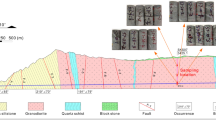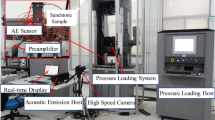Abstract
After engineering excavation, high axial stress makes hard rock to also have significant rheological behaviors that can lead to long-term instability. In order to study the long-term mechanical characteristics of hard rock after deep engineering excavation, field monitoring test and laboratory test are conducted. The results show that the initial fracture of rock mass in the area with rockburst is significantly higher than that in the area without rockburst. After a long time action of high ground stress, the internal fracture of rock mass with low initial fracture degree is not developed. In the rock mass with many initial fractures, the number and degree of internal fractures increase significantly after long time action of high ground stress, which eventually leads to the cracking of the lining of the nearby side wall. Through the true triaxial pre-peak and post-peak creep tests, the fracture process of rock under the condition of small and high initial fracture degree is simulated respectively. In the pre-peak stage (no final instability failure of the rock), the cumulative acoustic emission (AE) count rate of granite is coordinated with the deformation. There are significant acoustic emission quiet period and sudden increase of precursory information before instability failure. In addition, the creep failure of granite in the pre-peak stage is mainly dominated by tensile crack. In the post-peak stage, the cumulative AE count rate of granite is inconsistent with the deformation. Due to the formation of local macro-failure surface, the time-dependent fracture of granite is dominated by shear crack.
















Similar content being viewed by others
Data availability
The data that support the findings of this study are available from the corresponding author.
References
Chen BR, Feng XT, Ming HJ, Zhou H, Zeng XH, Feng GL, Xia YX (2012) Evolution law and mechanism of rockbursts at deep tunnels: time delayed rockburst. Chin J Rock Mech Eng 31(3):561–569
Fan Y, Zheng JW, Cui XZ, Leng ZD, Lv CC (2021) Damage zones induced by in situ stress unloading during excavation of diversion tunnels for the Jinping II hydropower project. Bull Eng Geol Environ 80:4689–4715
Feng XT, Yang CX, Kong R, Zhao J, Zhou YY, Yao ZB, Hu L (2022) Excavation-induced deep hard rock fracturing: Methodology and applications. J Rock Mech Geotech Eng 14(1):1–34 S1674775521001840. https://doi.org/10.1016/j.jrmge.2021.12.003
Feng XT, Zhao J, Zhang XW, Kong R (2018) A novel true triaxial apparatus for studying the time-dependent behaviour of hard rocks under high stress. Rock Mech Rock Eng 51:2653–2667
Grosse CU, Ohtsu M (2008) Acoustic emission testing. Springer, Berlin
Hao XJ, Feng XT, Yang CX, Jiang Q, Li SJ (2016) Analysis of EDZ development of columnar jointed rock mass in the Baihetan diversion tunnel. Rock Mech Rock Eng 49(4):1289–1312
Heap M, Baud P, Meredith PG, Vinciguerra S, Bell AF, Main IG (2011) Brittle creep in basalt and its application to time-dependent volcano deformation. Earth Planet Sci Lett 307(1):71–82
Hu L, Feng XT, Xiao YX, Wang R, Zhang W (2019) Effects of structural planes on rockburst position with respect to tunnel cross-sections: a case study involving a railway tunnel in China. Bull Eng Geol Environ 79:1061–1081
Jiang Q, Wang B, Feng XT, Fan QX, Wang Z, Pei SF, Jiang S (2019) In situ failure investigation and time-dependent damage test for columnar jointed basalt at the Baihetan left dam foundation. Bull Eng Geol Environ 78:3875–3890
Li W, Chen Y, Yuan X, Schurr B, Mechie J, Oimahmadov I, Fu BH (2018) Continental lithospheric subduction and intermediate-depth seismicity: constraints from s-wave velocity structures in the Pamir and Hindu Kush. Earth Planet Sci Lett 482:478–489
Li SJ, Feng XT, Li ZH, Chen BR, Jiang Q, Wu SY, Hu B, Xu JS (2011) In situ experiments on width and evolution characteristics of excavation damaged zone in deeply buried tunnels. Science China 54(1):167–174
Malan DF, Vogler UW, Drescher K (1997) Time-dependent behaviour of hard rock in deep level gold mines. J South Afr Inst Min Metall 97(3):135–147
Martin CD, Chandler NA (1994) The progressive fracture of Lac du Bonnet granite. Int J Rock Mech Min Sci Geomech Abstr 31(6):643–659
Ohno K, Ohtsu M (2010) Crack classification in concrete based on acoustic emission. Constr Build Mater 24:2339–2346
Peng J, Wong L, Liu G, Teh CI (2019) Influence of initial micro-crack damage on strength and micro-cracking behavior of an intrusive crystalline rock. Bull Eng Geol Environ 78(4):2957–2971
Wang FY, Huang HW, Zhang DM, Zhou ML (2022) Cracking feature and mechanical behavior of shield tunnel lining simulated by a phase-field modeling method based on spectral decomposition. Tunn Undergr Space Technol 119:104246 S0886779821004375. https://doi.org/10.1016/j.tust.2021.104246
Wang Z, Feng XT, Yang C, Zhou Y, Gao Y (2020) Experimental investigation on fracturing process of marble under biaxial compression. J Rock Mech Geotech Eng
Xie HP (2019) Research review of the state key research development program of China: deep rock mechanics and mining theory. J China Coal Soc 44(5):1283–1305
Zhang S, Ma T, Tang CA, Jia P, Wang YC (2020) Microseismic monitoring and experimental study on mechanism of delayed rockburst in deep-buried tunnels. Rock Mech Rock Eng 53(16):2771–2788
Zhao J, Feng XT, Zhang X, Yang CX (2019) Brittle and ductile creep behavior of Jinping marble under true triaxial stress. Eng Geol 258:105157
Zhao J, Feng XT, Yang CX, Zhou YY, Zhang Y (2021) Study on time-dependent fracturing behaviour for three different hard rock under high true triaxial stress. Rock Mech Rock Eng 1:1–17
Acknowledgements
We are particularly grateful for the kind assistance provided by Ms. Xinyue Wang and Mr. Mengfei Jiang.
Funding
The authors gratefully acknowledge financial support from the National Natural Science Foundation of China (No. 51839003, No. 41827806) and the China National Postdoctoral Program for Innovative Talents (No. BX2021060).
Author information
Authors and Affiliations
Corresponding author
Ethics declarations
Competing interests
The authors declare no competing interests.
Additional information
Publisher’s Note
Springer Nature remains neutral with regard to jurisdictional claims in published maps and institutional affiliations.
Rights and permissions
Springer Nature or its licensor (e.g. a society or other partner) holds exclusive rights to this article under a publishing agreement with the author(s) or other rightsholder(s); author self-archiving of the accepted manuscript version of this article is solely governed by the terms of such publishing agreement and applicable law.
About this article
Cite this article
Zhao, J., Feng, X., Guo, H. et al. Time-dependent failure characteristics of excavated rock masses in deep buried engineering: a field case and experimental study. Bull Eng Geol Environ 81, 520 (2022). https://doi.org/10.1007/s10064-022-03026-x
Received:
Accepted:
Published:
DOI: https://doi.org/10.1007/s10064-022-03026-x




